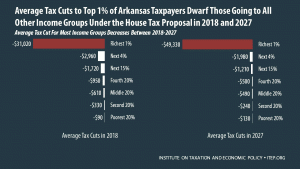
Those making less than $55,000 will see tax cut decline
A 50-state analysis of the House tax plan reveals that in Arkansas, the wealthiest 1 percent will receive the greatest share of the total tax cut, and their share will grow through 2027. The value of the tax cut would actually decline over time for the middle class in Arkansas.
House leadership continues to tout this tax proposal, which will increase the federal deficit by $1.5 trillion over the next decade, as a plan to boost the middle class. But a closer examination of the bill’s provisions reveals that it is laser-focused on tax cuts for the nation’s highest-earning households. Part of the reason that the wealthiest Arkansans’ share of our state’s tax cuts would grow over time is that the plan initially reduces the estate tax but then repeals it by 2024.
Due to how the plan accounts for inflation, benefits for taxpayers who earn their income from work, rather than investments, would erode over time. Additionally, the bill creates, but then eliminates five years later, a $300 non-child dependent credit that benefits low- and middle-income families.
More specifically, the 10-year outlook for the plan reveals that by 2027, the top 1 percent of households in Arkansas would see their share of the tax cut increase from 29 percent in year one to 44 percent by 2027, for an average cut of $49,330. Middle-income taxpayers’ average tax cut in Arkansas would erode from $610 in the first year to $490 in 2027, and the poorest 20 percent’s average tax cut would stay nearly stagnant, going from just $90 initially to $130 in 2027.

“This bill may cut taxes for some low- and middle-income households, though many of them will see no benefit at all. But let’s be clear: it is still the case that it will primarily benefit the rich, across the nation and in Arkansas,” said Rich Huddleston, executive director of Arkansas Advocates for Children and Families. “We’ve sent our elected officials to Washington to represent us – a relatively poor state. What they’re not saying is that these tax cuts that mostly benefit top earners will add to the nation’s annual deficits and come at the expense of low- and middle-income families.”
That’s because any gains that low and middle-class families might see under the GOP plan would, in the long run, likely be wiped away by budget cuts to federal programs in a myriad of areas including health care, food assistance, education, financial assistance for college and much more.
“The ‘savings’ have to come from somewhere,” Huddleston said. “Combined with benefit cuts, the value of the tax cuts could be virtually wiped out.”
The 50-state report was compiled by the Institute on Taxation and Economic Policy. Following are some highlights of how the plan affects Arkansas:
- The bottom 60 percent of Arkansas taxpayers (those with incomes less than $55,000) will see an average tax cut of only $340 in 2018, and that would decline to an average tax cut of just $270 by 2027. Their share of the total tax cut pie would be only 19 percent in 2018 and 2027.
- The poorest 20 percent of taxpayers would receive only 2 percent of the total tax cuts in 2018 and 3 percent in 2027, while the middle class would receive only 11 percent of the tax cut in 2018 and 10 percent in 2027.
- The wealthiest 1 percent would see their tax cut increase from $31,020 in 2018 to $49,330 in 2027.
Tables with Arkansas-specific impacts of the tax plan are available at these links:
Arkansas Impacts of the House Tax Plan in 2018
Arkansas Impacts of the House Tax Plan in 2027
More Arkansas charts are at this link.
To read the entire report or get more details about Arkansas, go to https://itep.org/housetaxplan.
